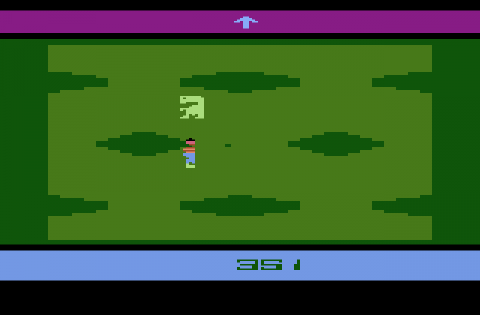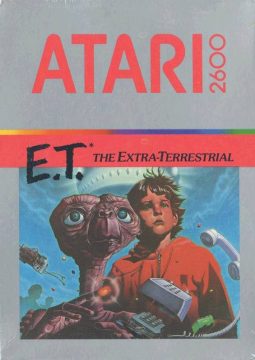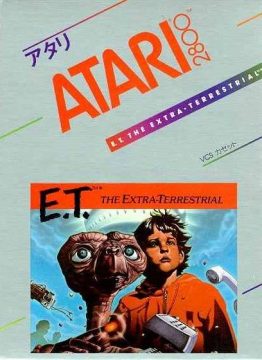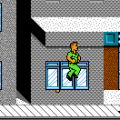No one remembers the worst game ever made. We don’t remember the games that are purely awful; we remember the games that fail spectacularly. Amidst a grey sea of interactive flash ads and licensed LCD key chains, occasionally something truly terrible rises ominous from the waves of normalcy.
E.T. the Extra-Terrestrial is frequently regarded as the worst game ever. The financial collapse of Atari Inc and the 1983 crash of the entire North American video game market are blamed on E.T. It’s completely unfair of course.
While E.T. certainly isn’t the best game on the Atari, it’s far from the worst. In 1982, Quaker Oats (yes, that’s the same folks who normally make flavored oatmeal) alone released 14 games for the Atari that were all worse than E.T.The difference between E.T. and a game like Quaker Oats’ Sneak n’ Peek, a hiding go seek simulator that advertises its “three weird rooms” and “five hiding places per room!” on the box, is that Quaker Oats was failing pathetically. Quaker Oats was standing on the pitcher’s mound, reading a newspaper, and half-heartedly tossing a ball into the video game market. People cringed. Atari was an unhinged lunatic who strutted onto the pitcher’s mound, pulled out a loaded revolver, stared down the video game market, and growled, “Can ya’ bat a bullet, sonr?” People stared in disbelief.
The Calm Before the Storm
The original Atari 2600 is a particularly difficult machine to program for. While incredibly flexible, it was initially designed to play pong and tank games, cheaply, in 1977 with 128 bytes of RAM. Its joysticks have a single button. Atari games usually have sound effects but no music, because the sound chip is not only very basic, it was designed mostly out of tune to save on costs. The Atari has a one dimensional graphics chip so bizarre it could take an entire book to explain. In 1980, Howard Scott Warshaw was asked by Atari brass to port Atari’s complex Star Castle arcade game to the 2600, and he flatly told them it was impossible. HSW created Yar’s Revenge instead, a game that incorporates the best aspects of Star Castle within the Atari’s limitations.
Yar’s Revenge would achieve critical and commercial success that would get HSW put on the project to develop a Raiders of the Lost Ark game, based on Stephen Spielberg’s incredibly successful film. In the process of creating the Raiders game he got to know Spielberg personally. When Atari got the rights to a game based on Spielberg’s next blockbuster movie Stephen Spielberg, himself, requested HSW for the project.
Atari gave HSW one severe stipulation for the project: the game would have to be out for the Christmas season. Atari’s planned release date would give HSW five weeks to program the entire game. He could have told them no, the way he did with Star Castle, but he didn’t. HSW had told them Star Castle was impossible, because of the 2600’s limitations. He couldn’t tell them E.T. was impossible because of his personal limitations. He took the time limit as a challenge; and he accepted.
For a couple days he brainstormed, plotted, planned, designed, schemed, and had a face to face meeting with Spielberg on the project. As Warshaw energetically unfolded and unrolled charts and diagrams across the room and he explained the algorithms that would power its Artificially Intelligent enemies, Stephen Spielberg smiled patiently and asked, “can’t we do a Pac-Man clone, Howard?”
“No,” was the historic response. Atari’s sheisty Pac-Man for the 2600 sold seven million copies, so in hindsight, Spielberg was right. A polished Pac-Man clone for the Atari with E.T. characters could have sold ten million copies and it would have been famous for other reasons.
HSW however took the road less traveled. In five weeks he created a game that embodied the concepts from the E.T. movie, featured legit AI, full color graphics, a randomly generated a persistent world, and cutscenes.
E.T. is dying. With every action, mistake, or footstep a counter at the top of the screen ticks down to his death. Before he dies, E.T. must assemble the pieces of a phone to call his spaceship back to the rescue. Two humans, a scientist and an FBI agent, try to hinder his progress. One human, Elliot, helps him out by feeding the alien Reese’s Pieces. Reese’s peanut butter candy is the only thing on Earth that can stave off E.T.’s imminent death.
E.T. can gather up Reese’s on his own. The game has a slightly convoluted system where the entire world is littered with invisible power zones, so when E.T. grabs some candy initially nothing happens. There’s a power zone that lets E.T. eat the candy and add time to his brief stay on Earth. This seems like an unnecessary step, but there’s also a power zone that lets E.T. feed Elliot the candy. A new player can use the candy to make the game easier, while experienced gamers can use the candy to bump up their high score. The power zones give the game a lot of replayability because they’ll be scattered randomly every time the game starts.
The FBI Agent will repeatedly chase ET down to steal all of his candy and phone pieces. In the movie the phone pieces included a speak and spell, so there’s this FBI agent who has found an alien life form and chases the greatest discovery in human history down through Washington, D.C. suburbs, the Lincoln Memorial, the Jefferson memorial, the ancient forests lining the Potomac, and a multitude of construction sites only to steal his candy and broken toys. That’s it. He robs E.T. of nearly worthless possessions, returns to Washington, and shows back up a few moments later (presumably after he ate all the Reese’s pieces) to rob him again.
E.T.’s only defense against the FBI agent is the “Lincoln Memorial” power zone. Using it causes the FBI agent to return to the Lincoln memorial… where he works? That’s it. There’s no interactivity there; the agent just heads out to the Lincoln Memorial and relaxes for a few seconds when E.T. activates the power zone. I’d like to imagine that the power zone is a brochure for D.C. tourism. The agent corners our beloved alien to rob him once more, but finds that all he has on him is a tour guide to the Lincoln Memorial. The agent stops and thinks, “You know I never really stop. I don’t stop to appreciate how beautiful a place it is where I work. I’m always caught up in the rat race of life, chasing extra terrestrial life form through construction sites. I really should relax and open my eyes a bit. I gotta go smell the flowers so to speak.”
Since FBI headquarters is definitely not located inside the Lincoln Memorial, perhaps he’s just a homeless man in a trench coat. It would explain why he keeps robbing E.T. for candy. It fits too since the “scientist” both works at the Jefferson Memorial and never does any “science” experiments. He just kidnaps E.T., drags him behind the Jefferson memorial, and holds him there for about five seconds…
None of the enemies in the game are really threatening. They just screw around and waste your time while E.T. slowly dies. The humans are easy to avoid, but they appear without warning at the edges of the screen, sometimes instantly on top of E.T. It divides the game subtly into two parts. First E.T. explores the map to make note of the power zone and phone piece locations. As long as E.T. is not holding a phone piece, the agent really has no impact on the game. The scientist/kidnapper is actually helpful in the exploration half, because he’ll walk over a lot of the hidden power zones in the process of kidnapping E.T. After you’ve mapped out the important stuff mentally or on a napkin, then grab the candy, assemble the phone, and call the space ship.
Power Zones
Jefferson Memorial
The Jefferson Memorial, or the Lincoln Memorial, it’s hard to tell. This power zone sends everybody back to Washington, D.C.
Call Elliot
The icon is either an “e” for Elliot, a face spitting out candy, or E.T. screaming for help. They all make sense, because the power zone calls Elliot to share some Reese’s pieces in exchange for higher scores, phone pieces, candy, and friendship. Also, as long he’s onscreen, the creepy FBI agent is off screen.
Bogart Candy
I think that icon is supposed to be a gaping mouth filled with candy. This power zone is the only place that E.T. can eat the candy he collects.
Metal Detector
The question mark shows any phone pieces on the current screen. It’s the most helpful of the optional power zones, because without it, E.T. would have to “explore” every pit of every screen.
Warp
An arrow points to one edge of the screen. This zone teleports E.T. one screen in whatever direction the arrow points. It’s useless unless the player has memorized which screens have which pit layouts. Otherwise it usually just drops E.T. into a pit.
Call Home
E.T. must use this zone to start the countdown for his ship to land and the story to come to an end. This zone is frustratingly nonfunctional when humans are the screen.
Landing
Unless E.T. stands exactly on this power zone his ship will refuse to land. This zone is supposed to be nonfunctional when humans are on the screen.
🙂
One of the few power zones that lets E.T. use his powers from the movie…
The game only has six screens, but never feels claustrophobic. It lacks the dead ends that border all other 2d adventure maps, because its screens are mapped to the six sides of a cube world. This works really well when ET is on the “sides” of the world looking for phone pieces. Each “side” of the cube world is a construction site littered with pits. If E.T. tries go “up” to the forest or “down” to Washington things get trippy.
E.T.’s world is intended to be a cube…
The Atari can’t rotate it’s screen so on the “sides” pressing up always takes E.T. to forest and pressing down always takes E.T. to Washington. However on the “top” of the world each direction is randomly mapped to a “side” screen, and it’s not even the same direction for the top and bottom screens. A player can hold up or down on the wrong screen and the game will flicker violently between two screens. The screen transitions in general are pretty bad. E.T. instantly appears on the next screen, and one of the game’s sides is covered in pits.
When E.T. falls into a pit, the game switches to platformer-style side view, but there are no platforms. E.T. just plummets to the bottom of the pit unless he floats. The pits can have phone pieces, secrets, or nothing. Usually it’s nothing. The colorful pit secrets are impressive, but sparse. It feels like HSW wanted to put a lot more down in the pits, but only had time for three secrets. The platformer view also makes it feel like the pits were initially planned to be Donkey Kong style platform sections, but there wasn’t enough time or space on the cartridge for it.
…but E.T.’s world actually works like this.
The pits are made so much worse by the controls. The collision detection is done with the Atari’s hardware to save time, so if one pixel of E.T. overlaps one pixel of a pit, he will fall in, even when he should standing in front of the pit.
E.T. can only perform one action in the pits: float. Hypothetically, since the Atari has only one action button one might expect it to: float. That’s not even remotely the case. If the action button is held down, released, or tapped E.T. will plummet to the pit’s bottom and take “fall damage” from it. The action button must be released and then held down until E.T. extends his neck. This only enters a “float mode”. Once in float mode the joystick must be pressed up to slowly float out of the pit. Once out of the pit the joystick must be pressed left, down, or right. If the action button is pressed or held down E.T. will immediately fall back into the pit, and if the joystick is pressed up, E.T. will fall back into the pit, but not immediately…
It is literally the most counter-intuitive control scheme ever. If someone were to suggest this for a modern game, people would take it as a joke. There are so many little things modern gamers take for granted in a video game. There are so many small victories. Yes rescuing Peach is a victory, yes dunking Bowser is a victory, and yes completing a level is a victory; but what about jumping from the ground to a block, running in a straight line, or just walking into a wall without dying. In E.T. everything hurts and the controls are so counter-intuitive that moving in a straight line requires logic, geometry, memorization, and a notepad.
If the pits weren’t broken enough, one screen has bonus pits. Every “side” screen has four pits that may or may not have something nice in the bottom. One screen has an additional four dummy pits that will always be empty. What makes this design choice even crazier, is that these useless dummy pits are positioned at the edges of the screen, so if E.T. walks onto the dummy screen without thinking about it, he immediately plummets into a pit.
Once the pieces are assembled E.T. can call home by activating the single “call home” power zone in the game, but only if there are no humans onscreen. This should be easy because E.T. can give them tourism brochures from the memorial power zone and they’ll head back to Washington, D.C. to check out the Jefferson or Lincoln Memorial. However, the humans are anti-social. Because of limitations in the Atari’s graphic chip, only one of the large, colorful, animated people can be onscreen at once. If there are folks already in Washington, D.C., the Memorial power zone will send the human to bottom of the current screen where they will wait, forever – unless E.T. runs around the cube world to jostle the AI.
Then E.T. must truck it to the “forest” screen and find the landing power zone. The ship won’t land if humans are onscreen either. As the landing counter ticks down, E.T. must run back and forth across the forest handing out brochures and standing in the landing zone. If everything goes according to plan, there will be an cut scene of the ship landing to wild, whirring sound effects, followed by a scene of Elliot running around his house and eating all of those Reese’s Pieces E.T. gave him throughout the game. Unless of course E.T. made the horrible mistake of calling Elliot to the forest with a power zone. Elliot will run in, naively expecting some Reese’s Pieces, and the space ship will crush him to death while E.T. watches frozen in horror…
If it sounds like I’m coming down hard on E.T., it’s only because the game could have been so much more. So many excellent pieces come so close to fitting together and miss. On its own, E.T. the Extra Terrestrial is a colorful game that can be beaten in ten minutes, takes years to master, and plays differently every time. It’s also the rare example of game that sounds better on actual Atari hooked up to a dusty television, than it does on crisp modern emulation. Its crunchy and otherworldly sound effects make great use of the Atari’s sound chip, and the crackle and distortion that gamers would have dealt with in a 1983 entertainment center only add to the game’s aesthetic. E.T. has a lot of clever pieces, but will be forever remembered for its failure to fully bring them together.
The Aftermath
E.T. the Extra Terrestrial sold over a million copies, outselling true classics like Donkey Kong and River Raid. However Atari had expected it to sell far more. The game over the years has become the poster child for Atari’s mismanagement under Warner Brothers. Under Warner Brothers, Atari forced retailers to buy old 1970s games if they wanted to buy new hits from Atari like Asteroids and E.T. They also forced retailers to buy mass quantities of games in advance, so that Atari could fudge their financial statements.
In 1983, Atari’s crooked business practices, their reliance on the aging 2600, their inability to keep third parties developers like Quaker Oats from filling store shelves with malarkey, and the declining quality of the flagship AAA titles all came back to bite them. Retailers began returning massive amounts of unsellable Atari merchandise and new orders began to dry up. Before Warner Brothers was able to sell Atari (and its debt) to the Tramiels, they resorted to destroying thousands of new games every month, to alleviate their taxes. This peaked when Atari sent 18 semi trailers out to the desert in Alamogordo, where they dumped millions of overproduced Atari hits like Asteroids, Pac-Man, and E.T. into a giant concrete coffin. This in itself has become become a sort of video game legend, and both gamers and journalists, thirty years later, have attempted to investigate this occurrence.
Jack Tramiel bought Atari and turned its focus from the once wildly successful 2600, to the then moderately successful Atari home computers. After the dust had cleared in 1986, the new Atari finally released the home computer version of E.T.
E.T. Phone Home for the 8-bit computers is fascinating, because it takes the core concept of Extra Terrestrial and marries it to traditional gaming tropes. The player starts off as Elliot looking for phone pieces while avoiding scientists and FBI agents. After assembling the phone, the player switches to E.T. and must travel to forest where a huge, impressive space ship lands.
The awkward cube world is replaced by a huge adventure map with a nice looking suburb and an imposing forest. The power zones are replaced with a mixture Pac-Man‘s maze running and stealth. Snap screen transitions are replaced with scrolling. The large, colorful, and oddly green alien, is replaced with a brown E.T. that fits comfortably into a maze adventure. The AI never has to worry about putting too many humans in one area, because the more powerful home computers could handle it. There are no pits, at all. E.T. Phone Home is a far more approachable game overall, but a little on the easy side.
The Survivors
While Raiders of the Lost Ark could be compared (unfavorably) to its offspring like The Legend of Zelda, Wolfenstein, Castlevania, or even Resident Evil, E.T. has no peers. So many of the coolest aspects of E.T. have become evolutionary dead ends. It’s balance between a world that is artistically designed and randomly generated is something that modern developers still struggle with. With the increasing size of modern games, game worlds are increasingly hard-coded into little chunks that the hardware can handle. E.T.‘s persistent world where the enemies are always active seems both anachronistic and futuristic. Certainly no game has ever recreated the cube world.
E.T. has a small, but devoted following of fans. They appreciate its quirks, its unique cleverness, its secrets, and a playful atmosphere of experimentation alien to the modern games industry. They also recognize how much the rest of the world hates and blames the game. Because of this there are several interesting projects to “redeem” E.T. the Extra Terrestrial.
Duane Alan Hahn created the guide book that should have come with E.T. on his site, Random Terrain. In addition to running the web’s best E.T. site and posting regularly about the merits of E.T. on Atari forums, he also participated in one of the most fascinating fan games ever made.
Michael Rideout (the programmer who won the Swordquest chalice) and Charles Gray created the E.T. Book Cart. It’s an ebook, on a physical Atari cart. Gamers can plug the Book Cart in between rounds of E.T. if they’re getting too stressed out. It contains interviews with Howard Scott Warshaw, quotes from ancient philosophers, an in-depth playing guide, theoretical essays by Hahn on the virtue of randomness, conspiracy theories about the Alamogordo site, and a small minigame based on the conspiracies.
Programmer, Rachel Morris, began work on a 3D Remake of E.T., that somewhat ironically highlights a few of the weirder aspects of the game.
More recently David Richardson AKA Recompile, hacked a ROM image of the original game. He changed E.T.’s color from green to its natural tan, and got rid of a few glitches like the one where Elliot is crushed by the space ship. Most importantly he fixed the collision detection on all of the pits. Even though the dummy screen still has dummy pits, E.T. can now enter the screen from any side without automatically falling into a pit. Howard Scott Warshaw praised the hackjob, saying that it brought integrity to the project.
If you want to personally check out E.T. you can find the original manual at Atariage and a comprehensive overview of the game at Random Terrain. With a bit of perspective, the “worst game ever made” can be quite interesting.
Links:
Fixing E.T. David Richardson fixes many of E.T.’s bugs.
E.T. Tips The guide that should have come with the game.
E.T. at Atariage An html copy of the orginal manual and more.
Interview with Howard Scott Warshaw Digital Press interviews the game’s creator.




